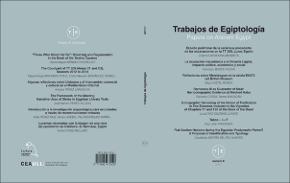The Framework of the Meeting Narrative Uses of Stelae in Egyptian Literary Texts
Author
Pérez-Accino, José RamónDate
2017Abstract
Egyptian stelae, whether private (funerary) or royal (commemorative), share a series of formal and structural elements, which allow them to be considered as two expressions of the same intellectual process and of a similar message. In terms of content, the relationship between the monarch and the deity is framed for purposes that may vary depending on the use and location of the stele, but beneath which lies an analogous structure. This relationship framework also seems to be expressed in various passages of the Story of Sinuhe, the Story of the Shipwrecked Sailor and the Report of Wenamun, in each of which a reference to a stela, defined by terminology and the appropriate formal context, seems to present the reader with a framework which indicates the relationship between the individual and a character of a higher category. Las estelas egipcias, ya sean privadas (funerarias) o reales (conmemorativas) comparten entre sí una serie de elementos formales y estructurales que permiten considerarlas que permite considerarlas como dos versiones diferentes de la expresión de un mismo proceso intelectual y de un mismo mensaje. En su contenido, la relación entre el monarca y la divinidad se enmarca en razón de propósitos que pueden variar en función de la ubicación de la propia estela, pero bajo la cual subyace una estructura similar. Este marco de relación parece haber sido expresado en algunos pasajes de la historia de Sinuhé, la historia del Naúfrago y en el viaje de Wenamón, en los cuales hace su aparición una referencia a una estela, con el uso de una terminología y contexto formal apropiado. Esto parece presente al lector con un marco referencial que apunta a la relación del individuo con una figura de mucha mayor categoría.





